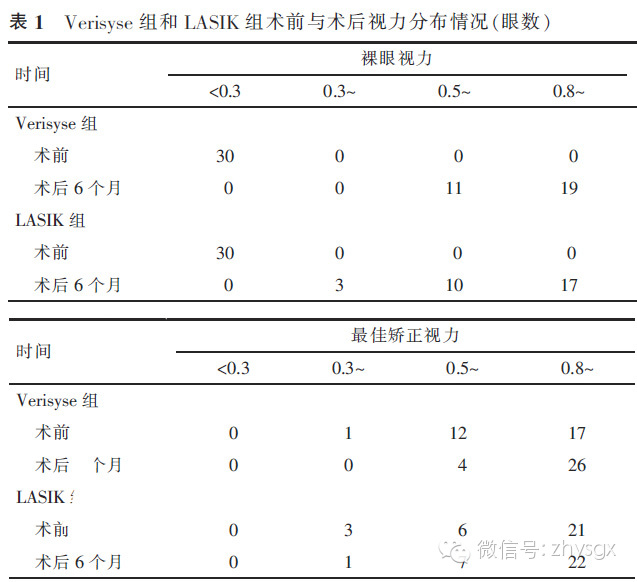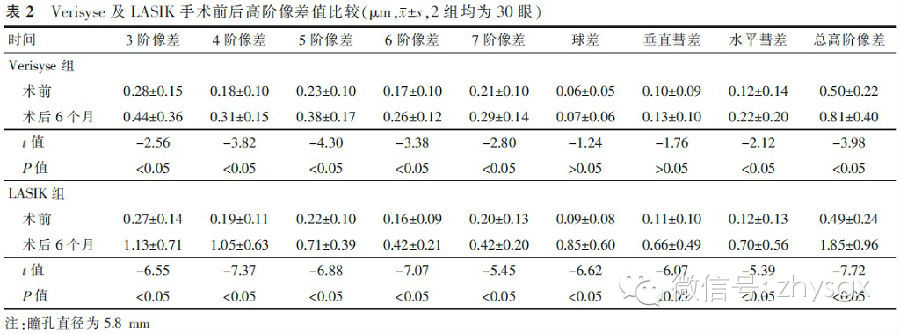王开杰 等 中华眼视光学与视觉科学

【摘要】 目的 评价有晶状体眼虹膜固定型人工晶状体(PIOL)植入术和准分子激光原位角膜磨镶术(LASIK)对高度近视眼视觉质量的影响,探讨高度近视优化的手术方案。方法 前瞻性非随机对照研究。选取于行LASIK(LASIK组)和Verisyse PIOL(Verisyse组)手术的高度近视患者各30例(30眼),2组术前等效球镜度分别为(-15.41±4.68)D和(-16.94±5.42)D,应用主观波前像差仪(WFA-1000B)分别于术前、术后6个月行波前像差检查,并进行主观评价问卷调查,2组数据之间进行t检验或χ2检验分析。结果 术后6个月2组间裸眼视力和最佳矫正视力均较术前明显提高,裸眼视力≥术前最佳矫正视力者Verisyse组占70%(21/30),LASIK组占43%(13/30),两者之间差异具有统计学意义(χ2=4.34,P<0.05)。2组3~7阶各高阶像差及总高阶像差均较术前增加,以LASIK组更为显著,Verisyse术后3阶像差为主导像差,其中水平彗差增加明显,与术前比较差异有统计学意义(t=2.12,P<0.05);LASIK术后3阶和4阶像差为主导像差,其中球差和彗差增加明显,差异有统计学意义(t=-6.55、-7.37,P<0.05);2组之间比较,LASIK组各高阶像差明显高于Verisyse组,差异具有统计学意义。患者术后满意度LASIK组为60%,Verisyse组为83%,差异具有统计学意义(χ2=4.02,P<0.05)。结论 虽然PIOL与LASIK矫正高度近视短期随访具有相似的安全性和有效性,但是从视觉质量角度来看,PIOL术后具有更好的裸眼视力,引起的高阶像差明显低于LASIK,且不存在屈光回退,满意度较高,可作为高度近视优先考虑的手术方案。
【关键词】 近视,退行性; 高阶像差; 角膜磨镶术,激光原位; 有晶状体眼人工晶状体植入术; 虹膜固定
DOI:10.3760/cma.j.issn.1674-845X.2014.06.010
基金项目:国家自然科学基金(81200673、51273113)
作者单位:100730 北京眼科中心 北京学与视觉科学重点实验室
通信作者:朱思泉,Email:siquanzhu@sina.com
Comparison of different refractive surgeries for correcting high myopia Wang Kaijie, Zhang Fengju, Zhu Siquan. Beijing Tongren Eye Center, Beijing Key Lab of Ophthalmology and Visual Sciences, Beiing Tongren Hospital, Capital Medical University, Beijing 100730, China
Corresponding author:Zhu Siquan,Email:siquanzhu@sina.com
【Abstract】 Objective To evaluate the quality of vision after implantation of a Verisyse phakic intraocular lens (PIOL) and laser in situ keratomileusis (LASIK) for correcting high myopia, and to evaluate a rational surgical approach for high myopia. Methods This was a prospective non-randomized control trial. Thirty eyes (30 patients) underwent LASIK and 30 eyes (30 patients) were implanted with Verisyse IOLs. Preoperative spherical equivalents were -15.41±4.68 D and -16.94±5.42 D, respectively. Wavefront aberrations were measured using a subjective aberrometer (WFA1000B) preoperatively and 6 months postoperatively. Higher-order aberrations (HOAs) were recorded and compared. Patient satisfaction (photic phenomena, overall satisfaction) was assessed by a subjective questionnaire. The data from the two groups was statistically analyzed by a t or χ2 test. Results Six months after surgery, uncorrected visual acuity (UCVA) and best corrected visual acuity (BCVA) had improved. Postoperative UCVA was equal to or better than preoperative BCVA in 70%(21/30) in the Verisyse group and 43.3%(13/30) in the LASIK group. The difference between the groups was statistically significant (χ2=4.34, P<0.05). 3rd to 7th order and total HOAs increased in both groups after surgery, especially in the LASIK group. In the Verisyse group, 3rd order aberrations were the predominant postoperative HOA and horizontal coma increased significantly (t=2.12, P<0.05); in the LASIK group, 3rd and 4th order aberrations were the predominant postoperative HOA, and coma and spherical aberrations increased significantly (t=-6.55, -7.37, P<0.05). Each order and total HOAs in the LASIK group were higher than that in the Verisyse group,and the difference was statistically significant. Patient satisfaction was 60% in the LASIK group and 83.3% in the Verisyse group (χ2=4.02, P<0.05). Conclusion PIOL and LASIK surgery were found to be comparatively safe and effective for high myopia. But when quality of vision is taken into account, UCVA was better with PIOL implantation and it resulted in a smaller increase in HOAs and higher patient satisfaction compared to LASIK. Therefore, PIOL implants may be considered as the first choice for high myopia.
【Key words】 Myopia,degenerative; Higher-order aberration; Keratomileusis,laser in situ; Phakic intraocular lenses; Iris-fixated

